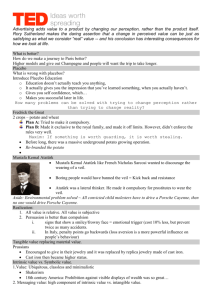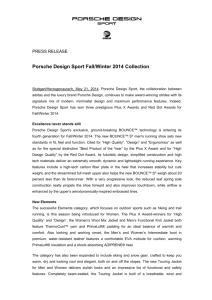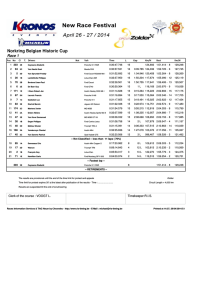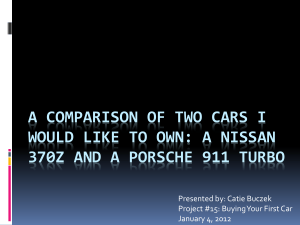Dr. Ing. hc F. Porsche AG
advertisement
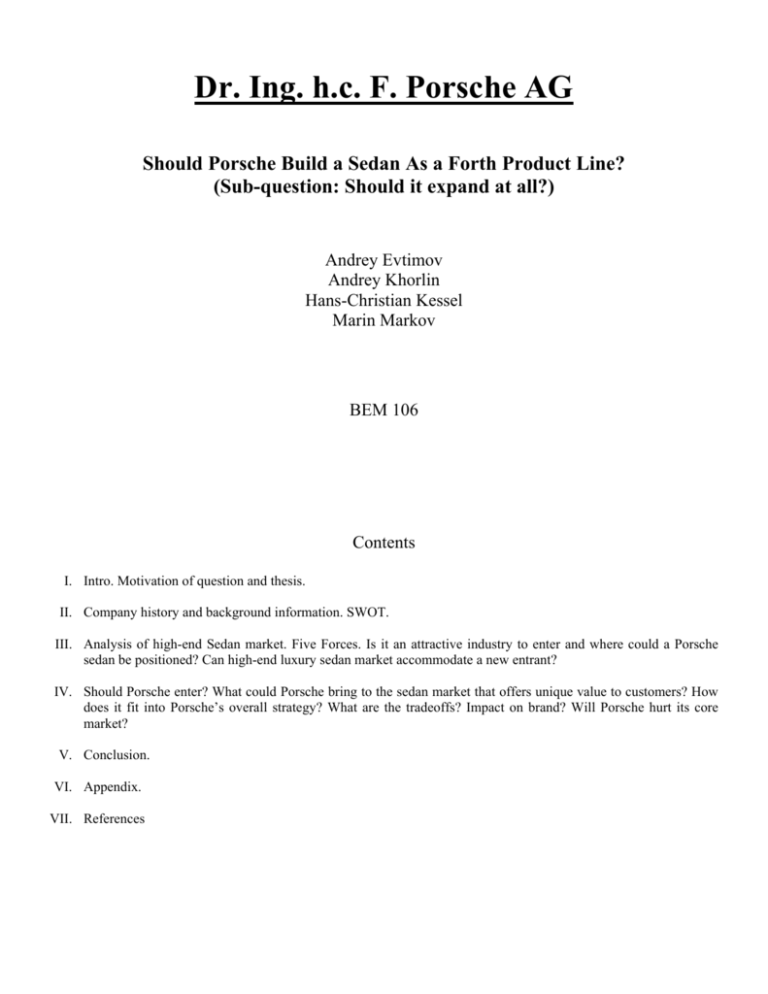
Dr. Ing. h.c. F. Porsche AG Should Porsche Build a Sedan As a Forth Product Line? (Sub-question: Should it expand at all?) Andrey Evtimov Andrey Khorlin Hans-Christian Kessel Marin Markov BEM 106 Contents I. Intro. Motivation of question and thesis. II. Company history and background information. SWOT. III. Analysis of high-end Sedan market. Five Forces. Is it an attractive industry to enter and where could a Porsche sedan be positioned? Can high-end luxury sedan market accommodate a new entrant? IV. Should Porsche enter? What could Porsche bring to the sedan market that offers unique value to customers? How does it fit into Porsche’s overall strategy? What are the tradeoffs? Impact on brand? Will Porsche hurt its core market? V. Conclusion. VI. Appendix. VII. References I. Introduction Porsche’s brand name has established itself as a symbol of quality and style as well as outmost technical skill and performance. It has managed to preserve its image as a manufacturer of great sports cars for more than half a century. Porsche’s desire to grow, however, conflicts with its original niche strategy (Appendix 4). The first step in expanding beyond the niche and thus increasing revenue was the recent introduction of an SUV. Further growth would most likely require Porsche to leave its niche even more endangering the image the built over the decades. Thus, it is crucial for Porsche to make a good strategic decision as to whether the risks of expansion in the sedan market are justified when the company’s core market is put at stake. Moreover, it is important for Porsche to review and reevaluate its desire to grow and decide whether expansion of the product lines would be more profitable for the company. II. • • • • • • • • • • y Company analysis and background information 1900: Ferdinand Porsche displays the Lohner-Porsche Electric Car in Paris 1928: Ferdinand Porsche develops sports cars for Mercedes Benz 1931: Porsche Engineering Office opened in Stuttgart 1936-38: development of first Volkswagen (VW) 1947: Ferdinand Porsche Jr. designs first Grand Prix car 1948: first Porsche sports car: 356 Roadster 1963: Ferdinand Alexander Porsche designs the 911 1991 to 1993: Crisis, mainly caused by ° recession ° low Dollar exchange rate to the German D-Mark ° high productions costs ° retro design which was not as popular as today 1993: Wiedeking new CEO 1996: Second product line introduced: Boxster 2002: Third product line introduced: Cayenne Wiedeking’s new strategies and emergence from crisis (1993 - ) • product strategy: ° new special models of each product line introduced on yearly basis over the entire life cycle resulting in wider variety catering to both the more comfort-orientated customer as well as the purist ° rapid development of Boxster positioned below 911 to attract younger customers ° search for new models to expand product line and reduce exclusive dependence on the cyclic sports car market ° termination of unprofitable low-volume models • production and cost reducing strategies: ° module assembly adopted from Toyota ° common parts for as many cars as possible (Boxster looks much like 911, high-value customer unhappy with easy confusability) to reduce costs ° increased parts outsourcing, e.g., motor management developed by Bosch, and assembly in Finland 2 ° ° ° ° more efficient supply management by reducing the number of suppliers reduce the size of the work force decrease hierarchy in company to facilitate flow of ideas cooperation with other firms (VW (former CEO was Piëch), Audi) to compensate for lack of knowledge in important fields and no direct competition between firms. 50% of Porsche owned by Piëch and Porsche family) ° Audi on V8 TDI (low emission Diesel) ° common platform on SUV (Cayenne, VW Toureg) ° V6 motor for Cayenne from VW • design strategy: ° retro design/ heritage (new 05 911 with round headlights again) ° SUV craze ° super sports car (1000 units @ 450k each, all spoken for already) • Porsche identity (Racing heritage): ° super sports car Carrera GT (based on 1998 Le Mans winner GT1, 215 kg V10 engine) to balance SUV Cayenne and keep sporty image ° innovations from racing: PCCB, PCCC (Ceramic Brakes, Clutch) ° Röhrl (former successful rally driver) hired for advertisements ° enter in multiple racing series: Porsche Cup, Pirelli Cup, ALMS ° no recent entries in Le Mans, F1: takes too many engineers from R&D of production cars, too expensive, risk of loosing image if performance is poor Current Product Line First Introduced Price Boxster 1996 45,000-55,000 911 1963 90,000-130,000 Cayenne 2002 $45,000-100,000 Carrera GT 2003 $450,000 Overall Position of the Company • • • • • Sales and profits in double digits and well above average (other automobile manufacturers, [23]), current growth sufficient and in line with company policy to keep risks limited (Exhibits 4, 5, 6 and 7) Successfully resists compromising the brand image and exclusivity by not offering rebates in difficult times Demand for the Cayenne likely to remain strong for the next 3-4 years Significantly faster at developing new products and more efficiently organized than 10 years ago Decline in core sports market sales in the last year or so (possibly cyclical, current models to be replaced shortly) , but overall growth due to introduction of Cayenne • Boxster o competition significant from other brands in the 30-50k price range: BMW Z4, Nissan 350Z, Mazda RX8, Audi TT, Mercedes SLK and others o lowest margins among Porsche product (only 10% of overall profits despite 40% of sales) and declining sales • 911 o o moderate competition from sports cars in 70-150k price range: Corvette, BMW Z8, Mercedes SL, Dodge Viper, Ferrari 360 Spider highest margin model accounting for 51% of profits 3 • Cayenne: o carefully positioned in high-power segment, but faces competition from Mercedes ML, BMW X5, Lexus • Super sport car (Carrera GT) o Strong competition from Mercedes SLR, Ferrari Enzo, Lamborghini Murciélago SWOT Strengths o Outstanding brand o Engineering capabilities o Loyal customer base o More agile than competitors Weaknesses o High reliance on the US market o Not diversified o Small in size and revenue compared to competitors o Unionized labor Opportunities Threats o Competition from other high-power • Leverage Porsche brand to expand brands with race heritage such as Ferrari, product line etc. could lead to declining brand value • Exploit cooperative relationships with o Declining core market sales VW and Audi o Foreign currency fluctuations III. Analysis of high-end luxury sedan market Product • • High-end, high-powered luxury sedan with sport characteristics Two broad categories: entry/mid-level (< $70K), and high-end (>$70K) Substitutes • • Luxury coupes and SUV’s, and to a smaller extent sports cars and limousines Other luxury items are (weaker) substitutes, since one can buy a more expensive house, a boat or jewelry instead of a luxury sedan Complements • • • Economic prosperity and a rising stock market create higher level of disposable income which translates in greater desire and ability to buy luxury cars Low currency exchange rates between Euro and Dollar make German/European cars more attractive worldwide. Currently, the situation doesn’t favor the European manufacturers Low interest rates lead to lower rates on car loans and better financing deals Incumbents in high-end luxury sedan space • • • German carmakers (BMW, Mercedes, Audi, VW) Japanese companies (Infinity, Lexus) Others (Cadillac, Volvo, Jaguar) All incumbents blame difficult market conditions for slow growth/decline in 2003. Some companies like Audi experienced stronger sales in high-end sedan market showing this segment is less cyclical and more dependable than the 4 rest of the market. In general, Japanese companies had higher growth than US and European ones. There are hints that recovery might take place in late 2004/2005 ([12 – 18]). Entry • • Barriers: For existing car companies, it is not particularly hard to enter the sport sedan market Recent entrants: Maserati Maserati (which has a brand image similar to Porsche’s for creating sports cars) has introduced its low-volume Quattroporte, which will probably position at a spot, where a potential Porsche sedan would be situated. Nature of Rivalry • • • High rivalry in the entry/mid-level sedan market [11], entering this market range looks risky high-level segment less rivalry, has most opportunity and is more consistent with Porsche’s brand. Thus, in the rest of the paper we assume Porsche would consider entry only in the high-end market segment. The rivalry also depends on geographic location of the market. Porsche is present in all important world markets, but core markets are Europe, Japan and the US. One particular other market is China which has lower levels of rivalry compared to the US or Europe. [See Appendix] Buyer power • • Wealthier people, upper-middle class and upper class No significant bargaining power, since they are too fragmented (but also have several options to choose from). Many specific high-end luxury models have waiting lists. Supplier Bargaining Power • • • Unionized European labor has bargaining power [9] Smaller input suppliers and sub-contractors have little bargaining power and are highly dependent on Porsche, well-working chain of suppliers in place Porsche is not vertically integrated (typically 20% of production for sports cars and 10% for Cayenne). Large suppliers (such as VW), which provide core components, could have great power. This is particularly relevant if Porsche considers joint entry with another German manufacturer. Co-ownership of VW and Porsche reduces potential to exercise bargaining power. Conclusion It will not be easy for Porsche to establish and sustain a good market position with the current production capabilities, rivalry levels, limited differentiation possibilities and established sedan brands (many of which also have a solid brand image such as Mercedes, BMW, Audi, VW, Maserati, Jaguar, Lexus, and others). The profit margins of the luxury sedan class cars are higher than that of lower- and middle- class sedans. This is more in-line with Porsche’s high-margin strategy and the only potential place Porsche could enter. 5 IV. Should Porsche build a sedan? 1. General considerations on expanding the product line • Porsche successfully designs product to be the standard in their class in terms of performance (trimmed to circuit racing rather than only straight line acceleration) • Unique, very highly-valued brand could propel a new carefully-designed product, as it happened with the Cayenne in the SUV market (prior to the Cayenne, there was no real “Sport” Utility Vehicle) • introduce a more fuel efficient product line compared to the gas guzzling SUVs while still offering more space than traditional sports cars • Desire to grow o It is uncertain that new 2005/2006 versions of current models will provide the source of growth comparable to Cayenne sales for the past two years o With declining core sales, the 20,603 Cayennes sold were the key to continued growth in 2002/2003 (Exhibit 7) [1], SUV sales on the US market are predicted to level off in 2005 (Exhibit 1 and 2), high gas prices might even decrease sales • Porsche’s labor is unionized and can potentially exercise its power, as could be seen in rest labor protest in Germany [9]. The potential for holdup could hamper Porsche’s growth and in particular Porsche’s ability to rollout a new product line or establish a new manufacturing facility. • Interest rates in the US might increase in the late 2004/early 2005 if signs of inflation begin to appear or the stock market heats up. It would be harder for manufactures to offer good financing deals to attract new customers. The current exchange rates could make the situation worse. 2. What unique features could Porsche bring to the Sedan market? • Porsche status combined with distillate of their knowledge, in particular exceptional handling and performance Porsche’s brand carries a level of uniqueness that differentiates it from rivals 3. Potential Benefits • Based on Cayenne’s success in conquering a completely new market, we could expect a Porsche Sedan to sell reasonably well at least in the short term and lead to further company growth • Potential synergies with other product lines • Incumbents (Mercedes, BMW, Audi and others) already compete in core Porsche markets, so it seems a natural reaction for Porsche to enter their territory. Moreover, Porsche shouldn’t worry about the response of those companies, as they have already attacked Porsche’s core markets without damaging it too much in Wiedeking’s opinion: ‘Sport sedans [from BMW, Mercedes, etc.] don’t really deserve the attribute “sport”.’ • The core US and European car markets could experience substantial periods of stagnation due to market saturation, economic uncertainty and unfavorable exchange rates. Introduction of a luxury sedan could position Porsche better in the global market and bring a healthy geographical and product differentiation. The growing Chinese market, for example, is more predisposed towards accepting a luxury sedan and is being successfully penetrated by Audi, BMW and Mercedes luxury sedans, while the share of SUVs and 2-door coupes remains low. It could be profitable for Porsche to exploit such developing markets and rollout a luxury sedan model at 6 least in target geographic locations. Such strategy might also allow Porsche to test out its luxury sedan design and contain potential damage in the geographic markets [5]. • Maserati is planning to release a new luxury sedan in the US in 2005 with predicted sales of about 1800 vehicles [3]. This suggests there might be a place for a new brand of luxury sedans with sporty image fueled by a desire for people to distinguish themselves. Porsche has an advantage over Maserati in the US market, as it enjoys a stronger brand image and better reliability, combined with better customer support and more dealerships 4. Risks • Strong competition: Audi RS6, BMW M5, Mercedes E55 AMG, Jaguar XJR, and to a lesser extent Lexus GS430, and Volvo S60 R: limited space for a Porsche luxury sedan • Porsche is a new entrant in the sedan market, other manufactures are very experienced and have loyal customer base • Porsche entry could hurt Audi’s sales, and have small overall returns to the Piech family, a main shareholder in Porsche and a large shareholder in VW/Audi (VAG). More importantly, a Porsche independent entry invading Audi’s space would likely strain Porsche’s generally cooperative relations with the other company’s management • SUV is a substitute for high-power sedan for customers with need for more space, building a new sedan could cannibalize sales of the Cayenne • The required investment is very high: Porsche would probably need a new factory, since even the recently built Leipzig plant is utilized at almost full capacity • Risks spreading its resources too thin. Despite its success, Porsche is a small company compared to giants such as Mercedes and BMW with only a few hundred engineers. The company currently has enough running projects that need attention: new 911 in July 04, Boxster in late 04, Cayenne face-lift, Carrera GT production beginning in April 04. It will be hard to allocate new resources to entering the sedan market, and even harder to compete successfully if the Porsche’s entry sparks a heated rival reaction. • Image of an exclusively sports car manufacturer might be severely damaged. Porsche risks alienating its core customers, who value the Porsche brand in part because it serves the purists’ market. As the psychographic profile of the Porsche buyer reveals (Appendix 1), a large portion of Porsche’s customers are attracted by a desire to be noticed, and by the status and power associated with Porsche’s brand. Some analysts already attribute Porsche’s sliding 911 and Boxster sales to core customer desertion after “the launch of an SUV has taken some of the magic away from the marque” [22] (despite some indications that cyclical factors are involved as well). As more Cayennes (particularly lower-priced V6 versions) are sold, Porsche’s brand will certainly become more visible on the road in association with a utility vehicle and not a pure sports car. In such circumstances, it seems imprudent for Porsche to introduce another controversial model before it has successfully defended its core markets and silenced the critics. If Porsche fails to signal its long-term commitment to being an exclusive sports car manufacturer, its 911 sales may easily become vulnerable to attacks from sports car models by traditional sedan companies like Mercedes and BMW. • Upscale competition (e.g., Ferrari) is likely to exploit this opportunity to attack Porsche’s brand and strengthen its own position. They rely, however, on the signaling effect of Porsche’s SUV or potential sedan rather than trying to bring it to the customers’ attention. To keep its high exclusivity, Ferrari will not enter into direct competition to displace a significant part of Porsche’s sales (there is no indication that this happened after the introduction of the Cayenne). However, even in the absence of such a direct attack, the Ferrari brand would be strengthened at the expense of Porsche as sports car enthusiasts appreciate Ferrari’s exclusive focus on sports 7 car. Porsche risks losing the high margins which were in part built and maintained by the perception that Porsche is a Ferrari peer on the racetracks that provides a lower-cost everyday alternative for sports car purists. V. Conclusion and strategy recommendations • Porsche is in a strong position to expand its product line • Don’t enter sedan market in the near future. While it is likely that a Porsche sedan will sell well in the short term, there is a significant long term risk of diluting brand identity and alienating core customers. Moreover, an entry into the sedan market will not be sustainable in the long term due to powerful competition and Porsche’s limited resources. • Think of other ways to expand the product line while staying closer to Porsche’s core market. For example, think about creating a coupe based on GT (does not rival VW, Audi) after Carrera GT production ends in 3-4 years. • Porsche should think whether it is possible and lucrative to diversify geographically and exploit successfully other growing markets (such as China, Taiwan, Korea and others in Asia for example). Positioning on such market might include introduction of new product line to fully capitalize on market potential. • Strategy in a nutshell, in words of Porsche commercial: ‘Change does not always require new ideas, sometimes ideas only require a little change.’ 8 VI. Appendix 1. A Psychographic Profile of the Porsche Buyer (Consumer Behavior, Hanna and Wozniak, Prentice Hall, 2001, pp. 281-82) The report indicated that the typical owner is a 40-something male college graduate earning over $200,000 per year. The report further categorized owners into five personality types as follows: Top Guns Top Guns represent 27 percent of owners. These individuals are driven and ambitious. Of primary importance to them are the matters of power and control as well as a strong desire to be noticed. Elitists Elitists represent 24 percent of owners. These individuals are old-money blue bloods. To them, a car is just a car, no matter how expensive it happens to be. They do not feel that the car is an extension of the owner’s personality. Proud Patrons Proud Patrons represent 23 percent of owners. To this group, ownership is an end in itself. Their car is a trophy earned for hard work. Bon Vivants Bon Vivants represent 17 percent of owners. These individuals are worldly jet-setters and thrill seekers. To them, the car is a means of heightening the excitement in their busy lives. Fantasists Fantasists represent 9 percent of owners. To these individuals, their car is an escape. Feeling a little guilty about having a Porsche, they avoid impressing others with the fact that they own one. As Mr. Ford glanced over the report, he thought of its possible implications to the two areas of car design and promotions. Concerning the first area, he wondered if it would be desirable to produce a different car model to fit the psychographic profile of each segment. Concerning promotions, he realized that ad appeals have to take into consideration both what motivates buyers and what turns them off. He regretfully recalled previous Porsche ads he once had approved that told buyers how good they look in the car and how fast they could go. He realized that those appeals were perhaps the wrong things to say when addressing a personality category such as the Elitists. 2. Survey of Incumbents in high-end luxury sedan space • German Carmakers (BMW, Mercedes, Audi, VW): o Audi: The revenue remained flat between 2002 and 2003. The number cars sold on the US market drop a little in 2003 and the number of cars sold in the world increased a little bit in 2003 compare to 2002. Audi increased its production of high-end luxury sedan, RS 6, from 2,052 in 2002 to 4,841 in 2003 while decreasing its entrylevel sedan production. Overall the level of production remained steady in the past four years [12]. This could indicate some moderate amount of potential in high-end luxury sedan space. o BMW: BMW vehicle production rose 1.5% in 2003 while the revenues fell 2.1% from 2002 levels. In the past 4 years the production rose 10% and in the past 15 years the production rose 20%. These numbers reflect the challenging environment for the luxury sedan makers according to BMW Annual Report [13]. o Mercedes (DaimlerChrysler): DaimlerChrysler data also reflects a challenging environment in the luxury sedan market in the past couple of years. In 2003, Mercedes Car Group increased its operating profit and revenue by 3% from 2002 level. The key component of Mercedes Car Group growth strategy is increasing leverage of Chinese Market [14, p15]. The Chrysler Car Group encountered operating loss in 2003 comparing to 9 2002. Despite negative outlook, Mercedes Group projects revenue increase of 20% by 2006. In addition, the unit sales in Q4 surpassing the figure for the prior-year quarter by 3% which might hint at the signs of market recovery [15]. • Japanese Carmakers (Infinity, Lexus) o Lexus: Toyota Corporation reports Lexus sales combined with Toyota brand, so it is hard to judge the growth of high-end sedan market from these numbers, but Toyota increased its production level by 11% from 2002 level. Toyota provides a notable exception to other manufacturers whose growth was hampered by global economic conditions in 2003 [17]. o Infinity: Infinity brand belongs to Nissan whose revenue rose 11.9% in 2003 and operating profits rose 11.1%. According to Nissan’s CEO, the large portion of the growth came from Infinity brand. The further expansion in 2004 for Infinity brand is planned to solidify and extend the gains [18]. • Others (Cadillac, Volvo) o Cadillac: GM doesn’t report separate sales for Cadillac and overall GM sales number are diluted by great number of brands. o Volvo/ Jaguar (owned by Ford): The revenue of Ford International Unit (Volvo, Aston Marin, Land Rover, and Jaguar) is increased from $44,567 millions in 2002 to $52,969 millions in 2003. Despite that revenue grown, the operating profit remained negative. The rest of the Ford Company division showed decline in revenue in 2003 showing the challenging market conditions [16]. 3. The Chinese Market as an Opportunity The core of Porsche markets is Europe and the US. However, one particular market of interest outside of the usual is China which have lower levels of rivalry compare to the US or Europe. The Chinese market is expected to consistently grow in the next 10 to 20 years becoming the leading booming car market in the world [10]. Currently, the leading position on the market is held by Audi that sold 50,000 units this year and expected to increase sale by 80,000 units in 2005. BMW and Mercedes are producing their luxury cars in China. BMW is planning to create producing from 8,000 to 30,000 by 2005. Mercedes is trailing BMW with expected production levels of 25,000 by 2012 [10]. Considering the strong position of Porsche’s ally Audi on Chinese market, Porsche can utilize this advantage to promote growth of not only existing line, but potentially a new line of cars. 4. Quotes from Articles and Interview with Porsche CEO Wiedeking • Business Week Online, Jan 12, 2001 (Interview with Wiedeking) Q: How much of an order backlog do you have at this point? A: Too much. Even today, after we've doubled our production [for turbo models] from 2,000 units to 4,000 units, we can't deliver a car to our customers in less than one year. That's too long a wait for such an expensive car. Q: What's the profile of Porsche buyers? A: The Porsche customer has always been [relatively] young. [In the U.S.] the typical 911 buyer is 46 to 65, average age 52. Household income: $310,000. The Boxster buyer is 36 to 55, with an average age of 47 [and] an average income of $243,000. [Buyers are] entrepreneurs, doctors. If the economy comes down, the customer base will be much more stable than in the past. Q: What can you offer with a sport-utility vehicle that's different? There are tons of them on the market already. A: There's no doubt that we have to transfer some of Porsche's typical features to the SUV. We know from our surveys that a lot of our customers are waiting for a Porsche SUV. Then there will be no doubt that customers can proudly park 10 their SUV next to a Mercedes S Class and other cars like that. On average, our customers own three cars: an SUV, a limousine or sedan, and a sports car. Q: You expect to sell 50,000 or more units this year, and you're adding the SUV, with 25,000-plus production in 2002. Could we see 100,000 units of annual production within five years? A: Maybe. • Business Week, Sep 15, 1997 (excerpts) Wiedeking's success blazes a trail for thousands of German manufacturers struggling against ever-tougher global rivals. Wiedeking … has pushed his workers to adopt Japanese-style lean production techniques, proving the wisdom in marrying Germany's strength in product engineering with efficient factories. A revamped assembly process will turn out the new 911 in just 60 hours, vs. 120 for its predecessor. Developing a new model, a process that used to drag on for seven years, now takes just three. Porsche uses 300 parts suppliers now, down from nearly 1,000. And a quality-control program has helped reduce the number of defective parts by a factor of 10. • Porsche mulls a sedan model, Automotive News, 9/15/2003 Porsche AG — a name synonymous with high-priced, high-performance vehicles — is considering a downshift into more mainstream sedan segments for its next model range. The so-called fourth Porsche now under study by the German luxury sports-car maker likely will be positioned well below the company's current range, CEO Wendelin Wiedeking disclosed at the Frankfurt auto show last week. "We are thinking about a fourth model range, and we have good ideas," he said. "But if the car we have in mind comes to the market, we will have fewer friends than we have today," he joked, a reference to the competition the car would pose to other automakers. He would not disclose the proposed vehicle's body style. Industry sources have said that Porsche has been studying a four-passenger coupe, code-named E2A, and a four-door sedan, code-named E2B. • Porsche is thinking about a 4th model line, Automotive News Europe, 11/18/2002, Vol. 7 (Interview with Wiedeking) Do you plan a fourth model line? It's very simple, after three comes four. The fundamental message behind this is that Porsche wants to grow in the future. And the question is what are the means to grow -- with a fourth model line, with derivatives, whatever. Porsche is following a growth strategy. But we want to stay independent and we want to have only exclusive products. That means that even with other models we'll want to follow the niche strategy. It will take until middle of next year, when the Cayenne is on the market worldwide. Then maybe we'll find the time to think of the next hill we want to climb. So you will decide about a fourth model line in the middle of next year? Not the decision. We would start the discussion, with expert groups in our company. There are some experts already exploring possibilities for the future. That's a must, that's their work. But I don't want to have this kind of discussion on the table at the moment, because now we have to focus all our resources on making the Cayenne and the sports car business stronger. 11 You have said that there will be no car below the Boxster. Is that still true? That's my intention. We are talking about the price range. There is a relationship between exclusivity and price. You can't call a cheap model an exclusive model. That doesn't work. When will Porsche be where BMW is today? I think the next big step for us is to beat the €10 billion in revenue. (Porsche's revenue in the year that ended July 31 was €4.86 billion.) When will you reach that? Wait and see. This company has huge potential for the future. A company with our size is always much more flexible in the market than a bigger one. If something happens you can react. The big players need too much time. 5. Exhibits Exhibit 1 (Comparison between Brands in the Luxury Sedan Class) [19, 20, 21] 2000 BMW M5 Engine Price: $69,970 Type: Supercharged V8 Miles Per Gallon: 13/21 mpg Displacement: 5439 cc Curb Weight: 3957 lbs Horsepower: 469 bhp @ 6100 rpm Layout: Front-Engine/RWD Torque: 516 lb-ft @ 2650-4500 rpm Transmission: 6-Speed Manual Redline: ---- rpm Engine Performance Type: V8 0-60 mph: 4.3 sec Displacement: 4941 cc 0-100 mph: 9.9 sec Horsepower: 394 bhp @ 6600 rpm Quarter Mile: 12.5 sec @ 116 mph Torque: 369 lb-ft @ 3800 rpm Skidpad: .83g Redline: 7000 rpm Top Speed: 155 mph (limited) Braking, 60-0 mph: 123 ft Slalom Speed: 63.7 mph Performance 0-60 mph: 4.9 sec 0-100 mph: 11.3 sec Quarter Mile: 13.3 sec @ 108 mph Skidpad: .90g Top Speed: 155 mph (limited) Braking, 60-0 mph: 129 ft Slalom Speed: 64.7 mph 2003 Mercedes-Benz E 55 AMG Price: $76,000 Miles Per Gallon: 14/20 mpg Curb Weight: 4237 lbs Layout: Front-Engine/RWD Transmission: 5-Speed Auto Speedshift 12 2001 Lexus GS430 2002 Audi RS6 Price: $82,700 Price: $51,213 Miles Per Gallon: 15/23 mpg Miles Per Gallon: 18/23 mpg Curb Weight: 4060 lbs Curb Weight: 3715 lbs Layout: Front-Engine/AWD Layout: Front-Engine/RWD Transmission: 5-Speed Tiptronic Transmission: 5-Speed Auto Engine Type: Engine Biturbo V8 Type: V8 Displacement: 4172 cc Displacement: 4293 cc Horsepower: 450 bhp @ 5700 rpm Horsepower: 300 bhp @ 5600 rpm Torque: 415 lb-ft @ 1950 rpm Torque: 325 lb-ft @ 3400 rpm Redline: 6600 rpm Redline: 6350 rpm Performance Performance 0-60 mph: 4.4 sec 0-60 mph: 5.8 sec 0-100 mph: 10.7 sec 0-100 mph: --.- sec Quarter Mile: 12.8 sec @ 108 mph Quarter Mile: 14.3 sec @ --.- mph Skidpad: .88g Skidpad: .--g Top Speed: 155 mph (limited) Top Speed: 149 mph Braking, 60-0 mph: 118 ft Braking, 60-0 mph: --- ft Slalom Speed: 66.5 mph Slalom Speed: --.- mph 2004 Jaguar XJR 2004 Volvo S60 R Price: $74,995 Price: $36,875 Miles Per Gallon: --/-- mpg Miles Per Gallon: 18/25 mpg Curb Weight: 3600 lbs Curb Weight: 3571 lbs Layout: Front-Engine/RWD Layout: Front-Engine/AWD Transmission: 6-Speed Auto Transmission: 6-Speed Manual Engine Type: Engine Supercharged V8 Type: Turbocharged Inline-5 Displacement: 4196 cc Displacement: 2521 cc Horsepower: 400 bhp @ 6100 rpm Horsepower: 300 bhp @ 5500 rpm Torque: 408 lb-ft @ 3500 rpm Torque: 295 lb-ft @ 1950-5250 rpm Redline: ---- rpm Redline: 6500 rpm Performance Performance 0-60 mph: 5.2 sec 0-60 mph: 5.4 sec 0-100 mph: 12.8 sec 0-100 mph: 14.4 sec Quarter Mile: 13.6 sec @ 104 mph Quarter Mile: 14.4 sec @ 100 mph Skidpad: .—g Skidpad: .--g Top Speed: 155 mph (limited) Top Speed: 155 mph (limited) Braking, 60-0 mph: --- ft Braking, 60-0 mph: 118 ft Slalom Speed: --.- mph Slalom Speed: --.- mph 13 Exhibit 2 (SUV Market Projects in the US) Emerging SUV Sub-Segment Projections Annual Vehicle Projections 1950 1750 1550 1350 Premium Crossover 1150 950 Luxury SUV’s 750 1999 2000 2001 2002 2003 2004 2005 YEAR Source: DRI/Ward’s, 1999 actuals-Automotive News Exhibit 3 (SUV Sales projects for Porsche in 2005) Luxury SUV Market Segment U.S Luxury SUV Sales Forecasts (Calendar year, thousands) Model Honda Acura MDX,SLX BMW X5, X7 Cadillac Escalade Ford Expedition/Excursion Land Rover, Dis, RR Infinity QX4,QX8 Toyota Lexus, Mercedes M-Class Navigator Lincoln Blackwood Porsche Cayenne Yukon / Yukon XL Tahoe Suburban Total 1999 2000 2001 2002 2003 2004 2005 0.7 1.3 23.9 251.4 29.4 19.2 89.2 45.2 39.3 9.8 26.7 23.3 264.3 27.2 21.5 104.6 52.8 37.9 39.8 36.3 23.3 209.2 22.9 18.2 79.6 42.3 31.5 2.1 55.2 122.2 4.9 681.9 103.3 149.8 121.8 943 131.5 178.5 138.5 953.7 43.4 38.9 26.1 204.6 23.9 18.2 79.8 45.4 29.3 7.6 1.8 129.2 170.4 133.8 952.4 44.2 39.9 27 208.3 23.9 18 81 45.6 28.6 7.1 13.7 129.5 163.4 129.9 960.1 43.3 38.9 26.2 195.2 22.5 19.1 82.1 49.5 29.1 6.3 13.5 109.4 155 116.7 906.8 44.3 38.7 26.6 188.7 28 27.8 82.1 46.3 28.8 6 13.6 56.5 150.8 122.2 860.4 Source: DRI.WEFA/Ward’s North American Light Vehicle Forecast Report 9/’01 14 Exhibit 4 Annual Change in Auto Sales by Company Exhibit 5 Change in Market Chare by Company 15 Exhibit 6 Historic Porsche Sales Porsche Sales 1993-2003 (Source: www.porsche.com) 6000 Sales (in millions of euro) 5000 4000 3000 2000 1000 0 93/94 94/95 95/96 96/97 97/98 98/99 99/00 00/01 01/02. 01/02. Years Exhibit 7 Historic Sales by Model Vehicle Sales by Model (Source: www.porsche.com) 35000 30000 25000 911 20000 Units Boxter Cayenne 928 15000 944/968 10000 5000 0 93/94 94/95 95/96 96/97 97/98 98/99 99/00 00/01 01/02. 01/02. Years 16 VII. References [1] Porsche Sales Figures 2002/2003, Porsche AG, http://www.us.porsche.com/english/usa/company/annualreport/group/figures/default.htm [2] “This SUV Can Tow an Entire Carmaker: Porsche’s hot-selling Cayenne has kept company rolling as it readies launches of new sports-car models”, Business Week, Jan 19, 2004 i3866 p40 [3] “Forbes’ First Drive: 2005 Maserati Quattroporte”, Dan Lienart, www.forbes.com [4] “Auto sales outlook positive; Wall Street gains may open more wallets”, Brendan January, Bergen Record Corporation [5] “Automobiles in China: A Market Analysis”, China Contract, 2000 [6] “Alternative Vehicles”, The Battery Man, June 2003 Volume 45, Number 6 [7] “2004 Phaeton: Volkswagen’s High-Luxury Sedan Sails into the U.S. Premium Market”, Volkswagen of America, Inc., http://www.engine-power.com/volkswagen/volkswagen_phaeton_press.html [8] “The Heavyweights: Deep Pocket Rockets”, Tony Swan, http://www.caranddriver.com/article.asp?section_id=15&article_id=6567 [9] “Thousands walk off job at Porsche and other factories in warning strikes as union battles for better wage offer”, Barry Shlachter, The America’s Intelligence Wire, Feb 3, 2004 [10] “BMW Gears up for Sales Increases”, China Daily September 13, 2003 (http://www.china.org.cn/english/2003/Sep/74998.htm) [11] “The Entry-Level Luxury Sedan Market Heats Up”, Miles Cook, www.edmunds.com [12] “Audi Facts and Figures, 2003”, Audi Corporation, www.audi.com [13] “BWM Annual Report, 2003”, BMW Group, www.bwmgroup.com [14] “DaimlerChrysler Annual Report, 2003”, DaimlerChrysler, http://www.daimlerchrysler.com [15] “DaimlerChrysler Financial Report Q4, 2004”, DaimlerChrysler, http://www.daimlerchrysler.com [16] “Ford Financial Report, 2003”, Ford, http://www.ford.com [17] “Toyota Financial Report, 2003”, Toyota, http://www.toyota.com [18] “Nissan reports record results for FY03”, http://www.nissan-global.com/EN/IR/NEWS/ [19] “Cars: All Makes”, 2004, http://www.fast-autos.net/makes.html [20] “'04 Jaguar XJR”, http://www.fantasycars.com/sedans/html/xjrnew.html [21] “Lexus GS430 (2001)”, Carey Russ, http://www.theautochannel.com/N/vehicles/new/reviews/2001/russ0129.html [22] Jorn Madslien, “Porsche's daring expansion plan“, BBC News Online business report, http://news.bbc.co.uk/1/hi/business/3307833.stm [23] “Porsche Annual Report 2002/03” http://www2.us.porsche.com/english/usa/company/annualreport/download/texts/bilder/Porsche_Geschaeftsbericht72 .pdf 17





